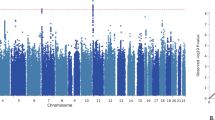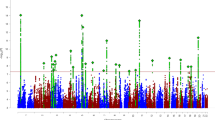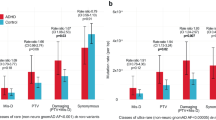Abstract
Several linkage analyses implicated the chromosome 9q22 region in attention deficit/hyperactivity disorder (ADHD), a neurodevelopmental disease with remarkable persistence into adulthood. This locus contains the brain-expressed GTP-binding RAS-like 2 gene (DIRAS2) thought to regulate neurogenesis. As DIRAS2 is a positional and functional ADHD candidate gene, we conducted an association study in 600 patients suffering from adult ADHD (aADHD) and 420 controls. Replication samples consisted of 1035 aADHD patients and 1381 controls, as well as 166 families with a child affected from childhood ADHD. Given the high degree of co-morbidity with ADHD, we also investigated patients suffering from bipolar disorder (BD) (n=336) or personality disorders (PDs) (n=622). Twelve single-nucleotide polymorphisms (SNPs) covering the structural gene and the transcriptional control region of DIRAS2 were analyzed. Four SNPs and two haplotype blocks showed evidence of association with ADHD, with nominal p-values ranging from p=0.006 to p=0.05. In the adult replication samples, we obtained a consistent effect of rs1412005 and of a risk haplotype containing the promoter region (p=0.026). Meta-analysis resulted in a significant common OR of 1.12 (p=0.04) for rs1412005 and confirmed association with the promoter risk haplotype (OR=1.45, p=0.0003). Subsequent analysis in nuclear families with childhood ADHD again showed an association of the promoter haplotype block (p=0.02). rs1412005 also increased risk toward BD (p=0.026) and cluster B PD (p=0.031). Additional SNPs showed association with personality scores (p=0.008–0.048). Converging lines of evidence implicate genetic variance in the promoter region of DIRAS2 in the etiology of ADHD and co-morbid impulsive disorders.
Similar content being viewed by others
Log in or create a free account to read this content
Gain free access to this article, as well as selected content from this journal and more on nature.com
or
References
Arbeitsgemeinschaft, für Methodik und Dokumentation in der Psychiatrie (2000). Das AMDP-System. Manual zur Dokumentation Psychiatrischer Befunde. Göttingen, Germany: Hogrefe.
Asherson P, Zhou K, Anney RJ, Franke B, Buitelaar J, Ebstein R et al (2008). A high-density SNP linkage scan with 142 combined subtype ADHD sib pairs identifies linkage regions on chromosomes 9 and 16. Mol Psychiatry 13: 514–521.
Becker T, Knapp M (2004). Maximum-likelihood estimation of haplotype frequencies in nuclear families. Genet Epidemiol 27: 21–32.
Cloninger CR, Svrakic DM, Przybeck TR (1993). A psychobiological model of temperament and character. Arch Gen Psychiatry 50: 975–990.
Costa PT, McCrae RR (1992). Revised NEO Personality Inventory (NEO PI-R) and NEO Five Factor Inventory (NEO-FFI) Manual. Psychological Assessment Resources: Odessa.
Dudbridge F (2008). Likelihood-based association analysis for nuclear families and unrelated subjects with missing genotype data. Hum Hered 66: 87–98.
Faraone SV, Biederman J, Spencer T, Wilens T, Seidman LJ, Mick E et al (2000). Attention-deficit/hyperactivity disorder in adults: an overview. Biol Psychiatry 48: 9–20.
Faraone SV, Perlis RH, Doyle AE, Smoller JW, Goralnick JJ, Holmgren MA et al (2005). Molecular genetics of attention-deficit/hyperactivity disorder. Biol Psychiatry 57: 1313–1323.
Franke B, Neale BM, Faraone SV (2009). Genome-wide association studies in ADHD. Hum Genet 126: 13–50.
Franke B, Vasquez AA, Johansson S, Hoogman M, Romanos J, Boreatti-Hummer A et al (2010). Multicenter analysis of the SLC6A3/DAT1 VNTR haplotype in persistent ADHD suggests differential involvement of the gene in childhood and persistent ADHD. Neuropsychopharmacology 35: 656–664.
Grabe HJ, Volzke H, Ludemann J, Wolff B, Schwahn C, John U et al (2005). Mental and physical complaints in thyroid disorders in the general population. Acta Psychiatr Scand 112: 286–293.
Halmoy A, Halleland H, Dramsdahl M, Bergsholm P, Fasmer OB, Haavik J (2010). Bipolar symptoms in adult attention-deficit/hyperactivity disorder: a cross-sectional study of 510 clinically diagnosed patients and 417 population-based controls. J Clin Psychiatry 71: 48–57.
Jacob CP, Muller J, Schmidt M, Hohenberger K, Gutknecht L, Reif A et al (2005). Cluster B personality disorders are associated with allelic variation of monoamine oxidase A activity. Neuropsychopharmacology 30: 1711–1718.
Jacob CP, Romanos J, Dempfle A, Heine M, Windemuth-Kieselbach C, Kruse A et al (2007). Co-morbidity of adult attention-deficit/hyperactivity disorder with focus on personality traits and related disorders in a tertiary referral center. Eur Arch Psychiatry Clin Neurosci 257: 309–317.
Klassen LJ, Katzman MA, Chokka P (2010). Adult ADHD and its comorbidities, with a focus on bipolar disorder. J Affect Disord 124: 1–8.
Kontani K, Tada M, Ogawa T, Okai T, Saito K, Araki Y et al (2002). Di-Ras, a distinct subgroup of ras family GTPases with unique biochemical properties. J Biol Chem 277: 41070–41078.
Korner A, Geyer M, Roth M, Drapeau M, Schmutzer G, Albani C et al (2008). [Personality assessment with the NEO-five-factor inventory: the 30-item-short-version (NEO-FFI-30)]. Psychother Psychosom Med Psychol 58: 238–245.
Lesch KP, Selch S, Renner TJ, Jacob C, Nguyen TT, Hahn T et al (2011). Genome-wide copy number variation analysis in attention-deficit/hyperactivity disorder: association with neuropeptide Y gene dosage in an extended pedigree. Mol Psychiatry 16: 491–503.
Lesch KP, Timmesfeld N, Renner TJ, Halperin R, Roser C, Nguyen TT et al (2008). Molecular genetics of adult ADHD: converging evidence from genome-wide association and extended pedigree linkage studies. J Neural Transm 115: 1573–1585.
Martin ER, Monks SA, Warren LL, Kaplan NL (2000). A test for linkage and association in general pedigrees: the pedigree disequilibrium test. Am J Hum Genet 67: 146–154.
Mayer CM, Cai F, Cui H, Gillespie JM, MacMillan M, Belsham DD (2003). Analysis of a repressor region in the human neuropeptide Y gene that binds Oct-1 and Pbx-1 in GT1-7 neurons. Biochem Biophys Res Commun 307: 847–854.
McGuffin P, Farmer A, Harvey I (1991). A polydiagnostic application of operational criteria in studies of psychotic illness: development and reliability of the OPCRIT system. Arch Gen Psychiatry 48: 764–770.
Moens CB, Selleri L (2006). Hox cofactors in vertebrate development. Dev Biol 291: 193–206.
Neale BM, Medland S, Ripke S, Anney RJ, Asherson P, Buitelaar J et al (2010a). Case-control genome-wide association study of attention-deficit/hyperactivity disorder. J Am Acad Child Adolesc Psychiatry 49: 906–920.
Neale BM, Medland SE, Ripke S, Asherson P, Franke B, Lesch KP et al (2010b). Meta-analysis of genome-wide association studies of attention-deficit/hyperactivity disorder. J Am Acad Child Adolesc Psychiatry 49: 884–897.
Nierenberg AA, Miyahara S, Spencer T, Wisniewski SR, Otto MW, Simon N et al (2005). Clinical and diagnostic implications of lifetime attention-deficit/hyperactivity disorder comorbidity in adults with bipolar disorder: data from the first 1000 STEP-BD participants. Biol Psychiatry 57: 1467–1473.
O'Connell JR, Weeks DE (1998). PedCheck: a program for identification of genotype incompatibilities in linkage analysis. Am J Hum Genet 63: 259–266.
Renner TJ, Walitza S, Dempfle A, Eckert L, Romanos M, Gerlach M et al (2008). Allelic variants of SNAP25 in a family-based sample of ADHD. J Neural Transm 115: 317–321.
Romanos M, Freitag C, Jacob C, Craig DW, Dempfle A, Nguyen TT et al (2008). Genome-wide linkage analysis of ADHD using high-density SNP arrays: novel loci at 5q13.1 and 14q12. Mol Psychiatry 13: 522–530.
Scholz CJ, Jacob CP, Buttenschon HN, Kittel-Schneider S, Boreatti-Hummer A, Zimmer M et al (2010). Functional variants of TSPAN8 are associated with bipolar disorder and schizophrenia. Am J Med Genet B Neuropsychiatr Genet 153B: 967–972.
Seshadri S, DeStefano AL, Au R, Massaro JM, Beiser AS, Kelly-Hayes M et al (2007). Genetic correlates of brain aging on MRI and cognitive test measures: a genome-wide association and linkage analysis in the Framingham Study. BMC Med Genet 8 (Suppl 1): S15.
Tamam L, Karakus G, Ozpoyraz N (2008). Comorbidity of adult attention-deficit hyperactivity disorder and bipolar disorder: prevalence and clinical correlates. Eur Arch Psychiatry Clin Neurosci 258: 385–393.
Williams NM, Zaharieva I, Martin A, Langley K, Mantripragada K, Fossdal R et al (2011). Rare chromosomal deletions and duplications in attention-deficit hyperactivity disorder: a genome-wide analysis. Lancet 376: 1401–1408.
Wingo AP, Ghaemi SN (2007). A systematic review of rates and diagnostic validity of comorbid adult attention-deficit/hyperactivity disorder and bipolar disorder. J Clin Psychiatry 68: 1776–1784.
Wylie CJ, Hendricks TJ, Zhang B, Wang L, Lu P, Leahy P et al (2010). Distinct transcriptomes define rostral and caudal serotonin neurons. J Neurosci 30: 670–684.
Zhou K, Dempfle A, Arcos-Burgos M, Bakker SC, Banaschewski T, Biederman J et al (2008). Meta-analysis of genome-wide linkage scans of attention deficit hyperactivity disorder. Am J Med Genet B Neuropsychiatr Genet 147B: 1392–1398.
Acknowledgements
This study was supported by the DFG (Grant RE1632/1-1, /1-3 and /5 to AR, KFO 125 to AR, CPJ, AW, SW, HS and KPL; SFB 581 to KPL, SFB TRR 58 to AR and KPL; RTG 1252, to AR and KPL; GR 1912/5-1, to HG), BMBF (IZKF Würzburg, 01KS9603, to KPL; IZKF N-27-N, to AR) and the EC (NEWMOOD LSHM-CT-2003-503474, to KPL). The Norwegian part of the study was supported by the Research Council of Norway and the Western Norway Regional Health Authority (Helse Vest). Financial support for the Spanish part of the study was received from ‘Instituto de Salud Carlos III-FIS, Spain’ (PI040524, PI041267), ‘Fundació La Marató de TV3’ (092330/31) and ‘Agència de Gestió d’Ajuts Universitaris i de Recerca-AGAUR'(2009SGR-00971). MR is a recipient of a ‘Ramón y Cajal’ contract from ‘Ministerio de Ciencia e Innovación’ (Spain). The Dutch part of the project was supported by the Hersenstichting Nederland (Fonds Psychische Gezondheid). SHIP is part of the Community Medicine Research net of the University of Greifswald, Germany, which is funded by the Federal Ministry of Education and Research (Grants no. 01ZZ9603, 01ZZ0103, and 01ZZ0403), the Ministry of Cultural Affairs and the Social Ministry of the Federal State of Mecklenburg-West Pomerania. Genome-wide data have been supported by the Federal Ministry of Education and Research (grant no. 03ZIK012) and a joint grant from Siemens Healthcare, Erlangen, Germany and the Federal State of Mecklenburg-West Pomerania. The University of Greifswald is a member of the ‘Center of Knowledge Interchange’ program of the Siemens AG. We thank J Romanos, A Boreatti-Hümmer and M Heine for their dedicated assistance in patient recruitment. T Töpner, N Steigerwald, G Ortega, J Auer, C Gagel, and N Döring are credited for excellent technical assistance. We thank Mariana Nogueira and Montse Corrales for their involvement in the clinical assessment in Spain, M Dolors Castellar and others from the ‘Banc de Sang i Teixits’ (Hospital Vall d'Hebron, Barcelona) for their collaboration in the recruitment of control subjects, and Cristina Sánchez-Mora for her participation in the preparation of DNA samples from patients and controls. We thank Marije Boonstra and Marten Onnink for help with patient inclusion, as well as Marlies Naber and Angelien Heister for DNA handling and genotyping. The Dutch controls were derived from the Nijmegen Biomedical Study. Principal investigators of the Nijmegen Biomedical Study are LALM Kiemeney, M den Heijer, ALM Verbeek, DW Swinkels, and B Franke. Finally, we thank all patients, families, and controls for their participation in this study.
Author information
Authors and Affiliations
Corresponding author
Ethics declarations
Competing interests
In the past 3 years, Jan K Buitelaar has been a consultant to/member of advisory board of and/or speaker for Janssen Cilag BV, Eli Lilly, Bristol-Myer Squibb, Organon/Shering Plough, UCB, Shire, Medice and Servier. Sandra Kooij has received research grants from Janssen BV and Shire, and is on the speaker's bureau of Janssen and Eli Lilly. Hans Joergen Grabe has received speakers honoraria from Bristol-Myers Squibb, Eli Lilly, Novartis, Eisai, Wyeth, Pfizer, Boehringer Ingelheim, Servier and travel funds from Janssen-Cilag, Eli Lilly, Novartis, AstraZeneca and the SALUS-Institute for Trend-Research and Therapy Evaluation in Mental Health. Henry Völzke has received research grants by Sanofi-Aventis and the Siemens AG. Susanne Walitza has received lecture honoraria from Janssen Cilag, Lilly and AstraZeneca. Christine Freitag was on the speakers' bureau for Novartis and Janssen-Cilag during the last 3 years. Helmut Schäfer has received a honorarium for a lecture from the European School of Oncology and has been a member of a Data Safety Monitoring Board of Daiichi Sankyo. Andreas Reif has received a research grant from Astra Zeneca. The remaining authors declare no conflict of interest.
Additional information
Supplementary Information accompanies the paper on the Neuropsychopharmacology website
Rights and permissions
About this article
Cite this article
Reif, A., Nguyen, T., Weißflog, L. et al. DIRAS2 is Associated with Adult ADHD, Related Traits, and Co-Morbid Disorders. Neuropsychopharmacol 36, 2318–2327 (2011). https://doi.org/10.1038/npp.2011.120
Received:
Revised:
Accepted:
Published:
Issue date:
DOI: https://doi.org/10.1038/npp.2011.120
Keywords
This article is cited by
-
Expression of the ADHD candidate gene Diras2 in the brain
Journal of Neural Transmission (2018)
-
Functional Impact of An ADHD-Associated DIRAS2 Promoter Polymorphism
Neuropsychopharmacology (2016)
-
Attention-deficit hyperactivity disorder in adults: A systematic review and meta-analysis of genetic, pharmacogenetic and biochemical studies
Molecular Psychiatry (2016)
-
Comorbidity of Personality Disorders and Adult Attention Deficit Hyperactivity Disorder (ADHD)—Review of Recent Findings
Current Psychiatry Reports (2016)
-
Imaging genetics in adult attention-deficit/hyperactivity disorder (ADHD): a way towards pathophysiological understanding?
Borderline Personality Disorder and Emotion Dysregulation (2014)



